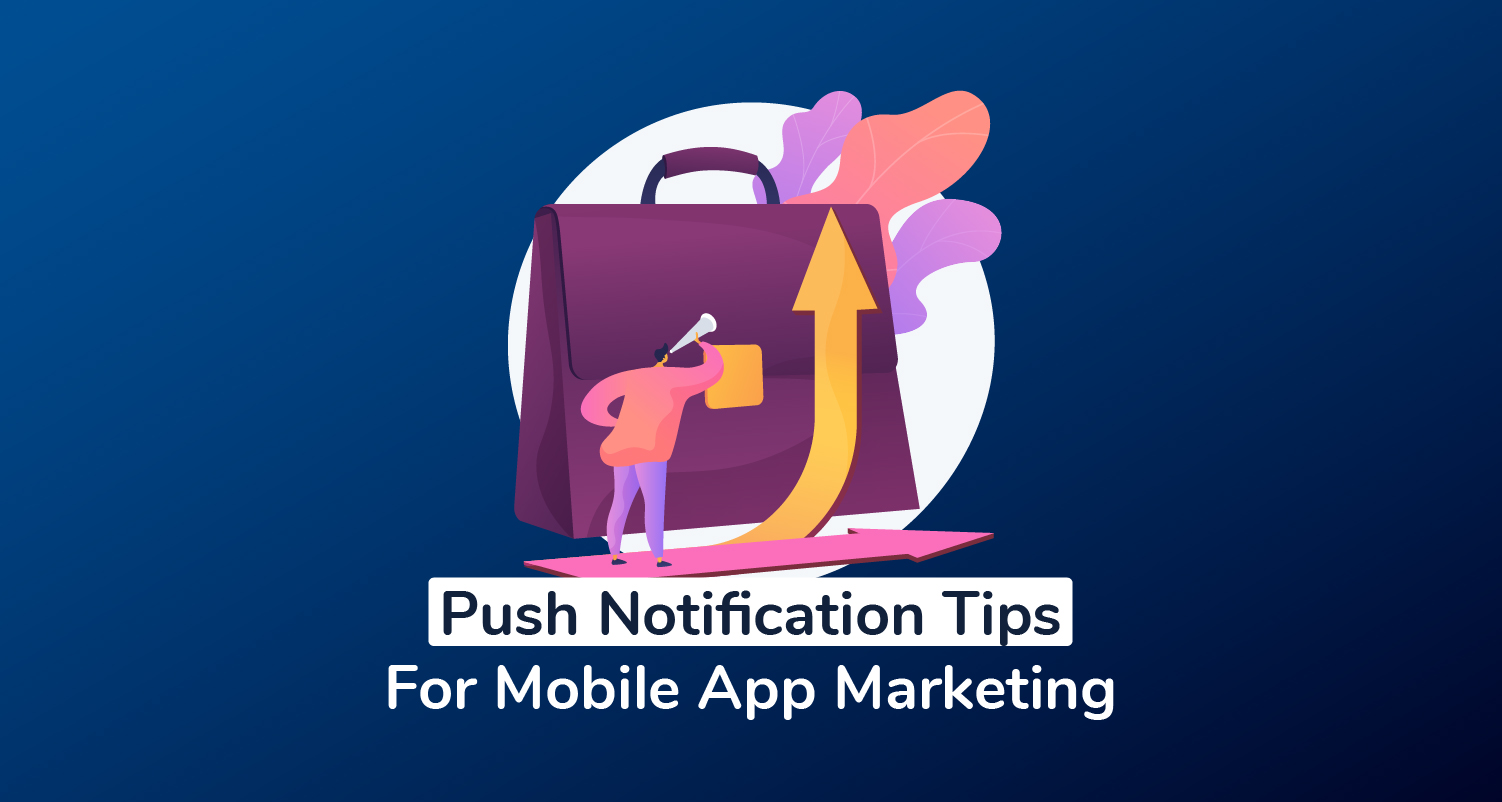
Mobile App Marketing Guide: The 2025 Trends and Facts
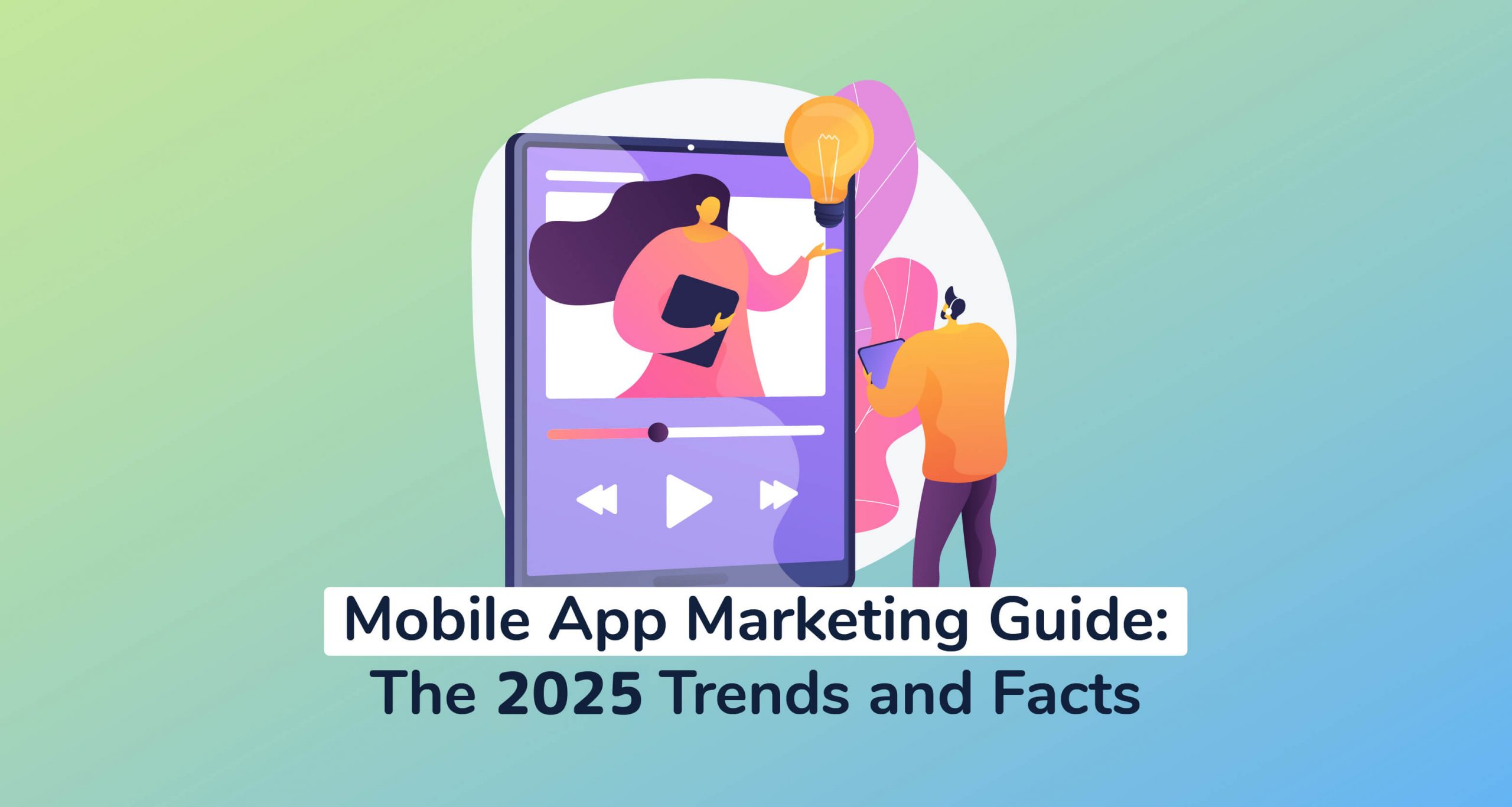
We’ve taken a step back and reviewed all the events, trends, technologies, and strategies that are shaping the mobile app marketing industry in 2025.
Table of Contents:
- Mobile App Marketing Statistics – What To Expect In 2025
- #1. Your Competitors Are Coming In Hot…But So Are The Potential Users
- #2. Court Publicity And Get Rewarded Handsomely
- #3. Use The Consumer-Centric STP Model To Target Audiences With Precision
- #4. Content Marketing Is Visual Just As It Is About Text
- #5. Artificial Intelligence To The Rescue With Data-Driven Strategies
- #6. You Can Count On Micro
- #7. Go Beyond Borders With Geolocation Marketing
- #8. Fight Back Against Ad Fraud
- Key Takeaways
While our previous articles fundamentally highlight all the mobile app promotion strategies that our experts have tested out and proven over the years, this one will be looking into the future.
PreApps has been in the business since the 2000s, and I can tell you for a fact that this year is turning out to be one of the most interesting ones yet.
And not just for app marketers. The dynamics are rapidly changing even for app developers, and mobile app users.
So, you might want to follow along as I reveal:
- The mobile market numbers in 2025.
- What to expect from your competition in 2025.
- The state of the Apple App Store and Google Play Store in 2025.
- How your target audience is responding to mobile app marketing campaigns in 2025.
- The tools and techniques that will change your mobile app marketing strategy.
- How to cope with the increased app market competition.
- Where hunt for potential users in 2025.
- The now redundant mobile app marketing strategies.
- Where you should channel your app promotion funds going forward.
And with that said, let’s jump right in…
50+ Mobile App Marketing Statistics – What To Expect In 2025
#1. Your Competitors Are Coming In Hot…But So Are The Potential Users
1.8 million. That’s the combined volume of apps and mobile games you’d find in the App Store back in 2015. Now, imagine taking on all those competitors against a market of less than 500 million iPhone users.
It wasn’t a walk in the park – I can tell you that. But then get this – that’s nothing compared to the level of competition you’ll be facing through 2025.
You see, the Apple App Store has more than doubled in volume since then. It now hosts over 3.7 million apps along with 1 million mobile games. So combined, you could say that the App Store apps and games add up to a little over 4.7 million.
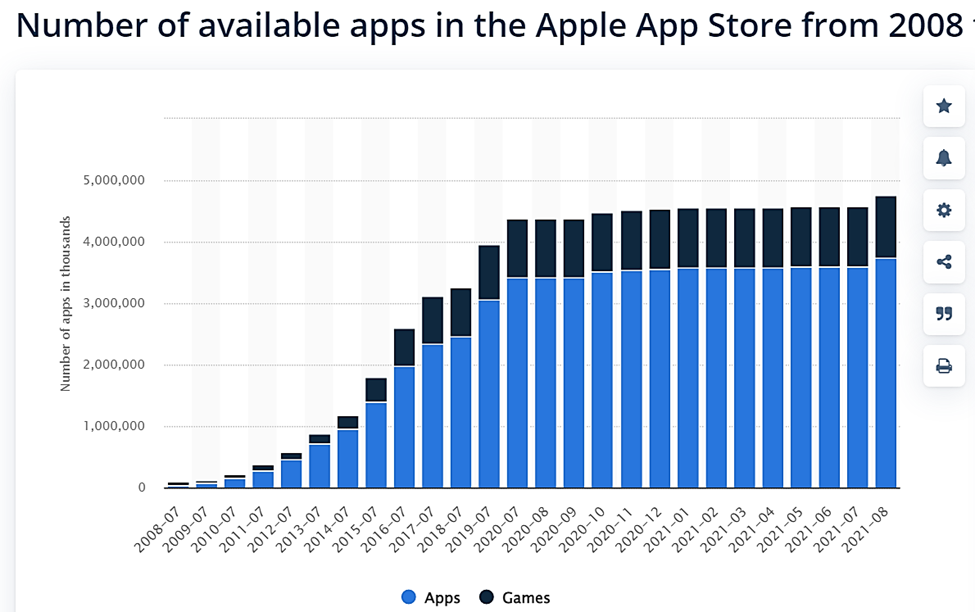
And the growth, you can bet, won’t be slowing down anytime soon. The App Store is now publishing over 30,000 new mobile apps per month. That means that on the day of your app launch, you can expect to share the limelight with at least 1,000 other iOS apps.
If you happen to pair your iOS app with an Android app, you’ll notice that the struggle can get worse on the Google Play Store. It is, hands down, the largest app store today, with a publishing rate of between 66,000 and 135,000 new apps per month.
That translates to about 2,000 – 4,500 Android app launches every single day, all struggling for attention and recognition.
Certainly not the type of play for amateurs. To win here, you’ll need a well-calculated mobile app marketing strategy.
Ok, and what about the mobile app users? How are they responding to the overflow of mobile apps across the two app stores?
Well, as it turns out, the corresponding user trends are somewhat encouraging. There are now over 6.6 billion smartphone users on the globe – of whom more than 3 billion happen to be running Android, while Apple itself boasts over 1.8 billion active devices.
Now that should give you a sizable target audience to consider for your app promotion. About 83% of the world’s population is already covered, and the numbers are projected to further expand to 7.5 billion by 2026 – which represents about 95%.
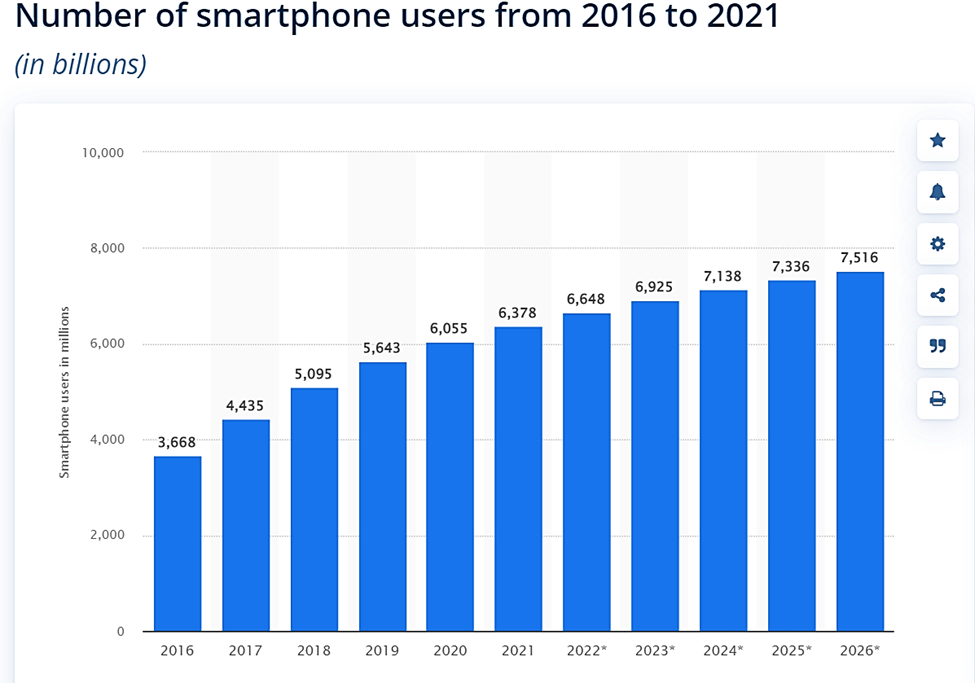
What does it all mean for you?
Well, for starters, never have we witnessed such a polarizing match-up of users and mobile apps.
Think about it – while the exceedingly high levels of competition are admittedly worrying, the correspondingly high volume of users translates into quick success for the few apps that manage to stand out from their competitors.
And that brings us to trend number #2 – mobile app growth has never been faster for the few that have truly mastered the art of war.
#2. Court Publicity And Get Rewarded Handsomely
Competition in 2025 is exceptionally stiff for all types of mobile apps. That we’ve ascertained.
But then get this – compared to the past years, the climb to the top is now much quicker for the few that truly know how to methodically market their mobile apps.
If you look at app install numbers, for instance, you’ll notice that as the volume of mobile users continues to swell, it progressively triggers a huge uptick in mobile app downloads and usage.
Back in 2016, for instance, all the app stores combined saw a total of 140 billion mobile app downloads. That’s a pretty solid number, but then get this – by 2021, the annual app download figures had risen by 63% to close the year at 230 billion.
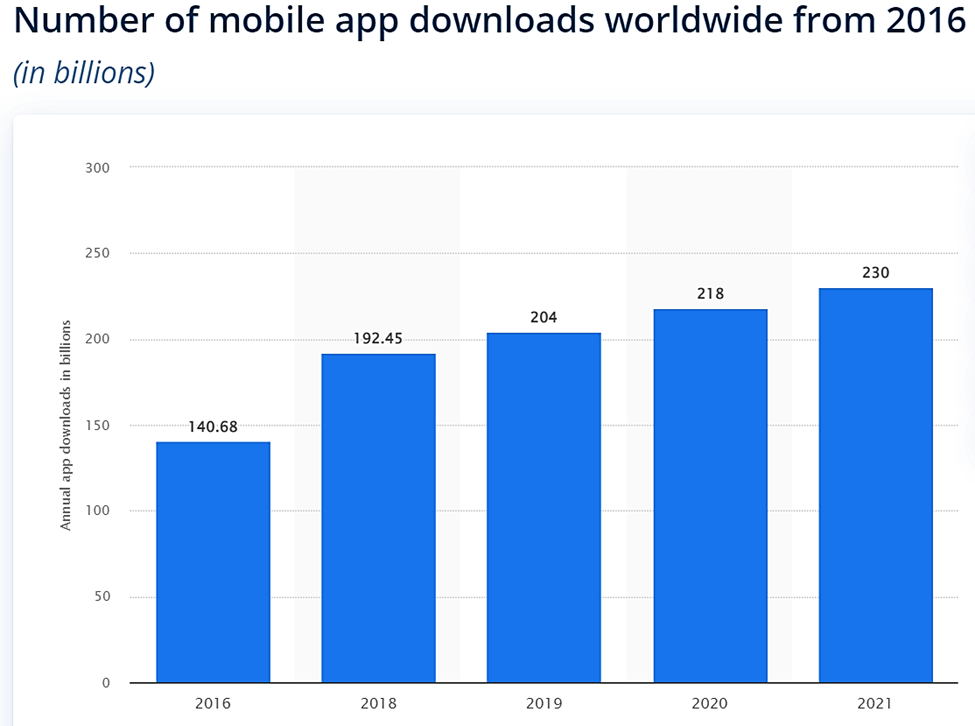
And it gets better. The growth trend is expected to persist through 2025 so that by 2026, we’ll be getting an annual count of at least 299 billion mobile app downloads.
Now, imagine attracting say, just 0.01% of that. It would add up to almost 30 million app installs within 12 months.
Quite achievable, if you ask me. All it takes is a well-built app and a meticulous mobile app marketing strategy.
I’m talking about things that we’ve achieved here at PreApps on multiple occasions. We’ve helped thousands of app owners outdo multitudes of competitors with a simple but well-thought-out mobile app marketing strategy.
And by “well-thought-out”, I mean systematically engaging your target audience at the right time, at the right place, and with the right message. Instead of hitting them with random landing page redirects or paid ads on social media, find clever ways to spark excitement, leverage user emotions, drive referrals, and build long-term loyalty.
One case example that has perfectly applied all that is TikTok. This mobile app came into the scene in 2016, at a time when people were convinced that the dominant social media platforms had an indomitable monopoly on the market.
The likes of Facebook, Twitter, Instagram, and YouTube were already ruling the airwaves, and it seemed like the status quo would be maintained into the foreseeable future.
But then TikTok dropped like a bombshell and ruined the party in a very impressive fashion. By facilitating the sharing of branded user-generated content across third-party social media platforms, it managed to strategically fuse user recommendation and influencer marketing into app video marketing.
In simple terms, TikTok found a clever way to court publicity. And the rest, as they say, is history. It’s the accelerated uptick in app downloads that ultimately catapulted TikTok to 2 billion app installs in half the time it took Facebook to achieve the same (despite facing less competition).
But, it didn’t stop there. Even after outshining Google in 2021, TikTok is set to close out 2025 as the third-largest social media network.
#3. Use The Consumer-Centric STP Model To Target Audiences With Precision
Target marketing is not a new concept in the mobile app marketing scene. We’ve been using it for years now to reach out to preselected audience segments across content marketing, social media marketing, landing pages, push notifications, SMS marketing, paid ads, and email marketing
Over the years, though, a majority of mobile app marketers have been restricting themselves to basic targeting techniques – which, more often than not, tend to end up with inconclusive results. Instead of dynamically narrowing down to the most qualified targets, such campaigns mistakenly prioritize quantity over quality.
Thankfully, this trend is now dying down thanks to the new range of advanced mobile app marketing tools. AI-driven platforms are giving them a simple way to leverage huge volumes of user data for multi-tiered targetting.
Through the months of 2025, quite a number of mobile app marketing professionals will strategically use machine learning to intelligently adapt app promotion campaigns to the exceedingly diverse and volatile profiles of modern audiences.
This is where the STP model comes in. It’s a specialized system that systematically combines segmentation, targeting, and positioning to dynamically relay appropriate messages to various qualified user groups.

You can think of it as a very simple way to streamline market segmentation and audience targeting. It helps you not only group audiences based on preselected parameters, but also prioritize the most qualified targets, and, ultimately, ran the most effective marketing strategy for each group of targets.
And how does this all work?
If you’re dealing with a mobile gaming app, for instance, you might consider including a segment of U.S, U.K, and Germany-based targets.
In that case, it just so happens that, according to a NewZoo survey, 95% of computer gamers in these countries are also fond of phone games. Consequently, you might want to throw in the condition as one of the defining parameters.
Then to top it off, you could choose to focus more on men, as they’ve been proven to spend more on such mobile apps.
Google Universal Ad Campaigns (UAC) is one platform that has perfected the art. You can use it to target your audiences with dynamic paid ads across different Google-owned platforms.
#4. Content Marketing Is Visual Just As It Is About Text
There’s no denying that content marketing is a fairly popular strategy for promoting mobile apps. It helps not only with SEO, but also landing page conversions, lead generation, and audience engagement.
That said, the popular assumption was that text is good enough as long as it’s written in a simple and digestible manner. You’ve probably seen, for instance, these bland mobile app landing pages that come with long feature lists.
Well, that was the standard way of doing things, until it became apparent that internet users are not that attentive. According to a report published by Microsoft, their average attention span is barely 8 seconds – which, strangely, is even shorter than a goldfish’s.
As such, you can’t really count on them to hang around your website and landing pages for that long. Contentsquare’s 2021 Digital Experience Benchmark report quotes 54 seconds as the average time spent on web pages – which is pretty insufficient for driving conversions.
The situation in the two most popular app stores is even worse. As it turns out, 60% of your App Store visitors tend not to proceed past your page’s first impression. That leaves you with only about three seconds to convince them to download the mobile app.

Quite a difficult position, I must admit. But, some mobile app marketers have found a simple solution around it.
You see, instead of banking on text alone, they are gradually shifting to dynamic content structures. They’ve learned to supplement regular written content with relevant visual media- like app demo videos plus images.
And science, as a matter of fact, continues to prove them right. Studies have shown that the brain processes visual content 60,000 times faster than written text. What’s more, the brain is subconsciously selective, favoring visuals over text – hence, 90% of the info is usually transmitted in visual form.
#5. Artificial Intelligence To The Rescue With Data-Driven Strategies
Consider this – in essence, 41% of smartphone users say that they get rid of apps to increase their device memory space. 45%, on the other hand, do so after losing interest, 47% uninstall apps to declutter their screens, while 51% admit that they usually do away with apps that they rarely use.
This alone is enough to prove just how diverse mobile user preferences and behaviors can get. The more the user parameters you introduce, the farther the corresponding variables will extend. Combined, all these factors form an extremely complex web of preferences that would be hectic to keep up with – even when you’re dealing with only a handful of mobile app users.
And that’s why mobile app marketers are progressively adopting artificial intelligence tools. AI makes everything much easier by employing machine learning to not only monitor user behaviors but also analyze them systematically. The findings then come in handy when you need to automate a data-driven marketing strategy, as well as deliver personalized experiences to your target audience.

According to a research report published by Epsilon, 80% of users are willing to stick with a brand if it provides personalized experiences.
Even marketers themselves acknowledge the importance of personalization. 63% of them attest that it boosts conversation rates, while 31% have seen an increase in their business revenue.
So, it goes without saying that, mobile app marketing in 2025 will continue to capitalize on artificial intelligence to develop smart, deeply-personalized campaigns.
Software providers will, on the other hand, continue to develop computer algorithms that make marketing decisions based on real market data.
The free PreApps AppReport is a fine example of one. It’s already creating ripples in 2025 as an all-inclusive App Store Optimization (ASO) intelligence tool – with the ability to audit and track ASO performance, as well as help with the mitigation of any potential issues.
#6. You Can Count On Micro-Influencers To Stay On Top Of Things
In 2025, we don’t call them “influencers” anymore. That’s now a general term for pretty much all the social media users who’ve amassed a reasonably large following.
So, to be more specific about the scale of followers you’re dealing with, marketers have found a way to classify them into three major groups:
- Mega-influencers: Mostly A-list celebrities with millions of followers.
- Macro-influencers: Your typical social media celebrity with less than 1 million followers. The number usually ranges between 10,000 and 1 million.
- Micro-influencers: Average Joes with less than 10,000 followers.
At first, you might be tempted to go for a mega-influencer because of their large following. But, perhaps unsurprisingly, it turns out that micro-influencers are the real deal when it comes to driving engagement.
A group called Social Public even did a comprehensive study about this, on a sample of more than 100,000 vetted influencers on their platform.
They ran not one, not two, but three different campaigns across social media sites like Twitter and Instagram. By the end of it all, it emerged that micro-influencers achieve 7 times better engagement rates than the rest of the subcategories combined.
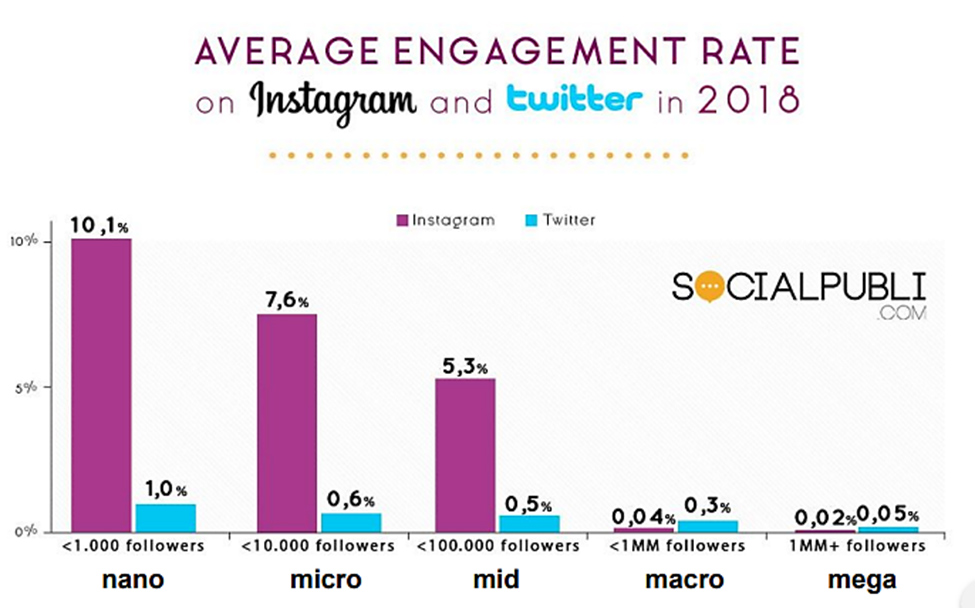
It doesn’t end there, though. A separate Experticity survey further established that micro-influencers outperform even recommendations from friends and family.
While 73% of consumers will possibly follow their friends’ recommendations, 82% of them are bound to act on recommendations made by micro-influencers.
Then guess what? Apart from being cheaper than their mega counterparts, you can rely on micro-influencers to be more committed to your entire mobile app marketing strategy. Give them an app review and they’ll run it for long as you want while actively engaging their followers.
In 2025, therefore, we expect to see more app marketers going for multiple micro-influencers to drive viral campaigns – as opposed to blindly contracting mega-influencers.
#7. Go Beyond Borders With Geolocation Marketing
Chances are, you’ve probably never heard of WeChat, QQ, Weibo, Youku, BiliBili, and the likes.
Ok, don’t get me wrong. These are not your regular generic apps. Although they are not that renowned in the West, the five mobile apps are incredibly popular Hall-of-Famers in China.
WeChat, for instance, is a messaging service that boasts about a billion users, while QQ lags slightly behind with 600 million app users. Weibo itself is a huge social media platform in China, whereas Youku and BiliBili are video streaming apps.
My point?
Well, based on China’s list of popular apps, it’s evident that there still exists a huge market disparity between different territories. An app that ranks exceptionally well in one country might, at the same, perform fairly dismally overseas.
And make no mistake of writing off these other unfamiliar countries.
Take China, for instance. This is the country with the highest number of mobile app users. It’s expected to generate 119 billion app downloads in 2025, dwarfing the United States’ 10 billion by close to 12 times.
Another giant that you might not have considered is India, which is projected to hit 37 billion mobile app downloads by the end of the year. That’s three times as big as the Unites States mobile market,
What does this mean for mobile marketing?
Quite simply, marketers will continue venturing into new territories by prioritizing geolocation marketing to capture new users. They’ll heavily leverage geo-fencing and geo-targeting tools while retweaking the standard app marketing parameters to adapt their campaigns to different languages.

If you expand to China, for example, it’s critically important to set up a corresponding app marketing framework in Chinese. Even your app press release, push notifications, and App Store Optimization should be prepared in the local language.
#8. Fight Back Against Ad Fraud
The mobile app marketing scene has not been without its fair share of security challenges. And to be specific, one of the biggest issues that are giving industry players sleepless nights is ad fraud.
This is a plague that started more than ten years ago in regular digital marketing platforms – such as affiliate programs. Criminals somehow found ways of using click farms and bots to fake impressions, after which the practice proceeded to spread like wildfire.
It didn’t even take long for ad fraud to morph within the digital marketing circles and find its way into the mobile app space.

Reports are now coming in of criminals employing ad stacking and false conversions to defraud even mobile app owners and marketers.
While the former is performed by placing multiple layers of ads together, the latter entails imitating typical customer behaviors through bots.
And that’s not all. Some crooks are now using an even more complicated technique called pixel surfing, through which they hide ads inside image pixels. In the end, marketers are forced to pay huge sums for falsified impressions.
By 2015, the annual loss estimates had reached $6.5 billion. They then more than doubled in just two years to hit $14 billion in 2017. Fast forward to 2025 and we’re now talking of losses in excess of $35 billion and still counting.
Now, the sad truth is, it might take some time before marketers are able to completely turn this around.
But, on the bright side, at least there are several mobile app marketers who’ve been fairly successful at combating ad fraudsters. They continue to develop sophisticated tools like app-ads.txt to tackle hidden ads and app-spoofing.
Key Takeaways
To keep you abreast with all that we’ve discussed, here are critical pointers that you ought to keep in mind regarding the State of Mobile App Marketing In 2025:
- In 2015, there were 1.8 million apps and mobile games in the App Store, against a market of less than 500 million iPhone users.
- The Apple App Store now hosts over 3.7 million apps along with 1 million mobile games. So combined, you could say that the App Store apps and games add up to a little over 4.7 million.
- The App Store is now publishing over 30,000 new mobile apps per month.
- On the day of your app launch, you can expect to share the limelight with at least 1,000 other iOS apps.
- The Google Play Store is the largest app store today, with a publishing rate of between 66,000 and 135,000 new apps per month.
- There are now over 6.6 billion smartphone users on the globe – of whom more than 3 billion happen to be running Android, while Apple itself boasts over 1.8 billion active devices.
- Smartphone users make up 83% of the world’s population, and the numbers are projected to further expand to 7.5 billion or 95% by 2026.
- Compared to the past years, the climb to the top is now much quicker for the few that truly know how to methodically market their mobile apps.
- Back in 2016, all the app stores combined saw a total of 140 billion mobile app downloads.
- By 2021, the annual app download figures had risen by 63% to close the year at 230 billion.
- By 2025, we’ll be getting an annual count of at least 299 billion mobile app downloads.
- A well-thought-out marketing plan systematically engages your target audience at the right time, at the right place, and with the right message.
- A majority of mobile app marketers have been restricting themselves to basic targeting techniques that mistakenly prioritize quantity over quality.
- AI-driven platforms are giving marketers a simple way to leverage huge volumes of user data for multi-tiered targetting.
- STP is a specialized system that systematically combines segmentation, targeting, and positioning to dynamically relay appropriate messages to various qualified user groups.
- STP helps you not only group audiences based on preselected parameters, but also prioritize the most qualified targets, and, ultimately, ran the most effective marketing strategy for each group of targets.
- According to a report published by Microsoft, the average attention span of an internet user is barely 8 seconds – which, strangely, is even shorter than a goldfish’s.
- Contentsquare’s 2021 Digital Experience Benchmark report quotes 54 seconds as the average time spent on web pages – which is pretty insufficient for driving conversions.
- 60% of your App Store visitors tend not to proceed past your page’s first impression. That leaves you with only about three seconds to convince them to download the mobile app.
- The brain processes visual content 60,000 times faster than written text.
- The brain is subconsciously selective, favoring visuals over text – hence, 90% of the info is usually transmitted in visual form.
- AI employs machine learning to not only monitor user behaviors but also analyze them systematically.
- 80% of users are willing to stick with a brand if it provides personalized experiences.
- 63% of marketers attest that personalization boosts conversation rates, while 31% have seen it increase their business revenue.
- Micro-influencers achieve 7 times better engagement rates than the rest of the influencer subcategories combined.
- While 73% of consumers will possibly follow their friends’ recommendations, 82% of them are bound to act on recommendations made by micro-influencers.
- China is expected to generate 119 billion app downloads in 2025, dwarfing the United States’ 10 billion by close to 12 times.
- India is projected to hit 37 billion mobile app downloads by the end of the year. That’s three times as big as the Unites States mobile market,
- By 2015, the annual loss estimates from ad fraud had reached $6.5 billion. They then more than doubled in just two years to hit $14 billion in 2017.
- The ad fraud losses in 2025 are in excess of $35 billion and still counting.
Conclusion
Mobile app marketing in 2025 going forward feels like a concoction of sorts. So, it’s understandable if you already have mixed feelings about it.
On one hand, we have a very promising market of app users, along with an exciting collection of intelligent mobile app marketing tools and techniques. Just what you need to get started on target marketing with advanced data-driven campaigns.
On the flip side, though, you can bet that your competitors won’t be taking it all lying down. Of the millions of rival mobile apps in the app stores, you can expect a huge majority of them to respond fiercely with their own app marketing campaigns.
They’ll take you on in the App Store, they’ll try to outbid you on the ad keywords, they’ll run paid ads on social media and search engines, they’ll send out volumes of app press releases, and some might even try to pull off smear campaigns. It’s all part of the game.
But, as a business person, I guess that’s no surprise. You already know what comes with stiff competition. Well, just as much as you recognize that it’s always advisable to delegate highly technical tasks to professionals.
So, don’t let your competitors beat you to it. Be the first one to get in touch with us, and we’ll be sure to put you miles ahead of them.
Our transformative mobile app marketing tactics will spearhead your mobile app growth, drive the mobile app downloads by the millions, and then proceed to retain your app users through targeted engagement.
Newsletter
Don’t miss a thing! Sign up to receive daily news
Subscribe Newsletter





